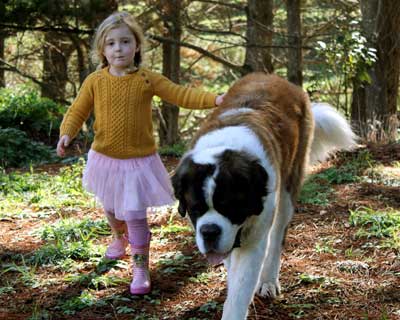Love them or not there is much to learn and understand about the responsibilities surrounding dog ownership and dog control
DOG TRAINING
Training your dog with basic commands can affirm human leadership and build a bond of obedience and trust between people and their dog. An obedient dog is also more enjoyable to be around. However, don’t rely on obedience training as being a ‘safeguard’. Obedience training teaches behaviour; it doesn’t always deal with misbehaviour.
The importance of consistency and persistency cannot be stressed enough. Make sure everyone in the family follows the same rules all the time because it’s very confusing for the dog if everyone teaches it something different. Dogs are much happier when they know what good behaviour and bad behaviour is. Dogs need to be clear about what we expect of them.
Basic obedience should include verbal commands like sit, stay, down (lie down), no and come.
Training sessions are more fun and more effective when they are short and often. Depending on the age and attention span of the dog you could do two or more sessions a day and make each one 5 minutes long.
Reward your dog with verbal praise, physical touch and the odd healthy treat.
Dogs don’t know right from wrong. Their behaviour is guided by instinct and what they learn to do. They will repeat things that give them pleasure and avoid things that cause discomfort.
Praise or reward the behaviour you want rather than punishing the behaviour you don’t want. When you discipline for the wrong behaviour the dog still doesn’t know what the right behaviour is. Distract or ignore the wrong behaviour.
If you want to praise or verbally reprimand a dog’s behaviour you must catch the dog in the act so to speak. If you wait longer than 2 or 3 seconds a dog won’t know what it was doing right or wrong. It’s pointless reprimanding a dog for something it did 1 minute, one hour or one day ago because there is too much time in between the behaviour and the praise/reprimand.
Practical Tips
Do not carry your dog or puppy.
Use the “down” or “lie down” commands often.
Make sure your dog obeys your commands immediately.
Feed your dog at regular times. Remove the bowl after 20mins.
Decide if your dog is to sleep inside or out and stick to it.
Do not make a fuss of arrivals or departures.
You decide…
…when and if to pat your dog
…when playtime starts and ends
…if your dog greets friends, strangers and other dogs
Start your obedience training early.
Puppies can begin learning basic commands from the time you get it at 8 weeks of age.
- Be patient while training your dog.
- Don’t lose your temper or shout at your dog if it does something wrong.
- Dogs have very good hearing and a firm voice is all that is needed.
- Remember that obedience training can take time; be persistent and consistent until the dog learns what you teach it.
- Children can also learn and use basic verbal commands.
- Don’t allow children or adults to pull at a dog’s leash or physically force it to do anything. It is better and safer to teach the dog to respond to verbal commands.
- Train your dog to walk properly on a leash.
- Your dog needs to walk at your side; it’s you that takes him for a walk not the other way round.
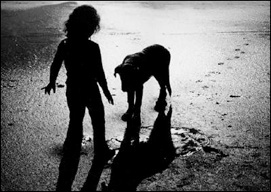
CHILDREN AND DOGS
Most dog related injuries happen to children, in their own home or the home of a relative or a friend and by a dog that they know.
When a dog is around, small children should be supervised at all times. They can unwittingly provoke an attack by attempting to take a bone or toy away from a dog, or by tugging and pulling or even attempting to cuddle a dog.
Dogs may also get excited by children’s’ games. This may result in a child being knocked to the ground, jumped at or chased.
Instinctively a dog may try to dominate a child because of the child’s small size.
With these points in mind, children should be taught basic safety habits around dogs, with parents and caregivers showing the way.
Dogs & Toddlers
Toddlers are especially vulnerable because of their small size, and lack of understanding of risks and verbal instructions. As a result they should be closely supervised at all times around dogs.
A toddler should not be allowed to be around dogs, (including puppies) without adult supervision. In addition they should not be allowed to put their face down to a dog’s face, or to hug or kiss it. Neither should they play with a dog’s food, feeding bowl, toys or bedding.
Parents and caregivers should ensure that toddlers do not wander into neighbouring properties where there may be dogs present.
School age children
School age children may put themselves at risk without thinking. They might be quite unrealistic about dogs and not appreciate the risk of being bitten – even by the family pet. For this reason, parents and caregivers should be sure to supervise children and dogs when they are together, and correct any unsafe behaviour.
DOG SMART
Christchurch City Council has developed a programme for the promotion of safety around dogs, and in particular, children around dogs. This fun and entertaining programme is called DogSmart.
The presentation takes the form of a PDF slide-show/video animation delivered by an animal control officer. It covers dog safety and bite prevention and also incorporates stickers, hats, word finds, evaluation sheets, coloured posters and card presentations.

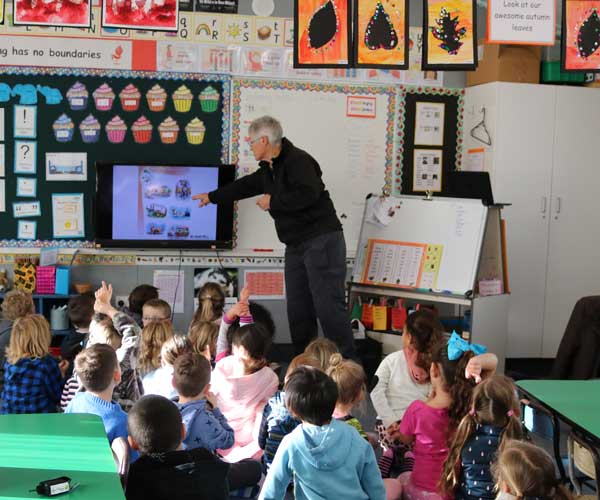
When it comes to safety messages, we believe reinforcement of the key messages is important.
Our children may not have had the opportunity to learn the essential skills to handle themselves around dogs.
Giving them the opportunity to learn safe correct techniques from a member of the Animal Control Team is a responsible and proactive way to help these students overcome their fear and anxiety.
A regularly scheduled presentation in alternate years could be an excellent way to ensure all your students get the safety messages and keep themselves safe from potential dog attacks.
A licensed agreement has been reached between Christchurch City Council and the NZIAM which allows animal control officers throughout New Zealand, who are signed-up members of the NZIAM, to use the DogSmart Educational Programme as a presentation tool in local schools or other seminar situations.
The DogSmart Programme can be presented at your school by your local Council. If you would like more information about the DogSmart programme, ask parents or teachers to contact either the NZIAM or Christchurch City Council, Education Co-ordinator at the addresses below:
Christchurch City Council Education Co-ordinator,
PO Box 73073,
Christchurch 8154
(NZIAM Members should access more details about DogSmart through the Members Login)
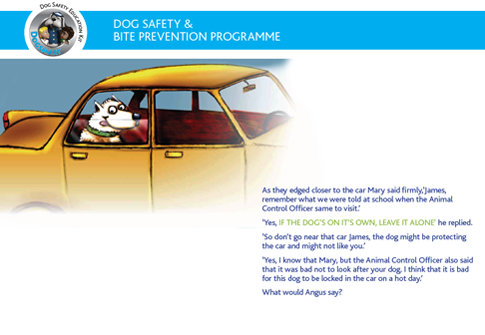
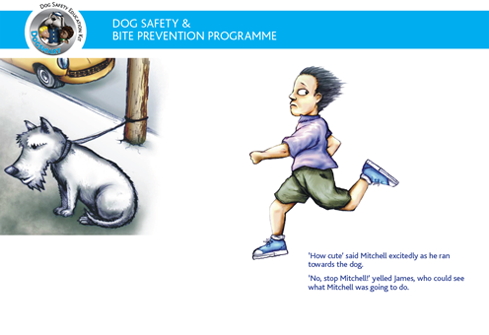
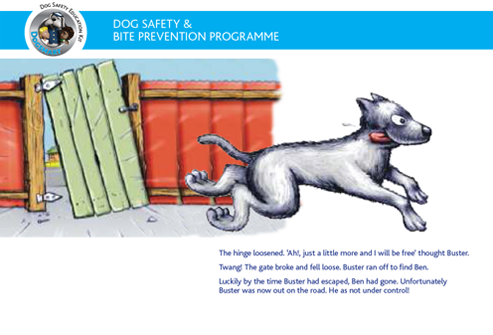
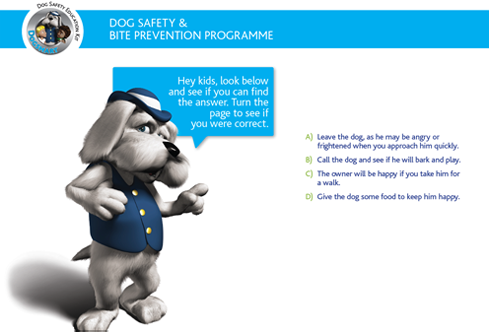
GENERAL SAFETY TIPS
All of us can contribute to dog safety, and keeping human – dog interactions pleasant and rewarding for everyone.
Here is some general advice regarding behaviour around dogs. The tips outlined below do not replace any legal obligations you may have, but will help dogs, dog owners, and everyone else get along well together.
- Always ask permission from a dog’s owner before approaching or petting a dog
- Pat dogs on their chests – NOT on top of their heads.
- Wait for a dog to sniff your hand before you pat it.
- Supervise your children at all times when a dog is nearby.
- Don’t let your children hug or kiss a dog or approach an eating or sleeping dog or one with puppies.
- Don’t act excited around a dog or run away, ride, or play noisy games, close to a dog.
- Do not force anyone who is afraid to pet a dog. (People afraid of animals sometimes make a dog uneasy and more likely to bite).
- If you are intimidated or annoyed by a dog, politely explain your concern to the dog’s owner and ask them to control it perhaps by putting it on a lead.
- If you are going to visit a property where you know there is a dog contact the owner first and ask them to restrain it.
Dealing with dogs and understanding them
You are likely to come into contact with dogs in a number of situations such as on the street, in parks and recreation areas, in your home or at the homes of family or friends.
Knowing how to behave around dogs will help you to deal with them more confidently and thereby minimise any risk of harm.
Like humans, each dog has its own temperament and behaviour patterns. This makes generalisation difficult. However, we can understand dog behaviour in terms of control and submission.
In the wild, dogs are pack animals with an instinct to strive to be ‘top dog’ within their pack. In play, puppies will often snarl or bite to assert their dominance over their siblings, and their owners.
Well-trained dogs have learned that their place in the family is submissive to humans, not dominant. However, even well-trained dogs can revert to aggressive behaviour when they feel threatened or scared. They can also become aggressive if they feel that their territory, food, toys or puppies are threatened, or when they become over-excited by noise or activity around them.
Reading a dog’s body language
Understanding the signals that dogs display will help you to know how to behave around them.
An aggressive dog will make itself appear larger by raising its hackles and standing on the tips of its paws. It may also bear its teeth and bark, growl or snarl. It will lay its ears back while raising its tail and it will stare directly at what or who it is threatening.
To calm the situation, you should stand still and avoid all eye contact. Look down and keep your arms still and folded in front of you, then slowly and calmly start moving away without turning your back on the dog.
By contrast, a frightened dog will make itself smaller by hunching or lying down. It will lay its ears flat and curl its tail between its legs. You can try and reduce the level of fear or threat by speaking quietly and smoothly. Again you should avoid eye contact and move slowly away staying side on to the dog.
A playful dog can still be worrying. It may bark without snarling. It will approach and retreat – often kneeling down and then jumping up – and it will hold or wag its tail horizontally. A dog that wants you to play may still be frightening, so to make him give up trying to get your attention you should stand still without making eye contact and then walk slowly and calmly away.
In all cases, you have a right not to be frightened or annoyed by a dog. If you complain, dog owners should respond courteously and control their dog. If you are concerned, you can contact the Dog Control Officer at your local Council.


